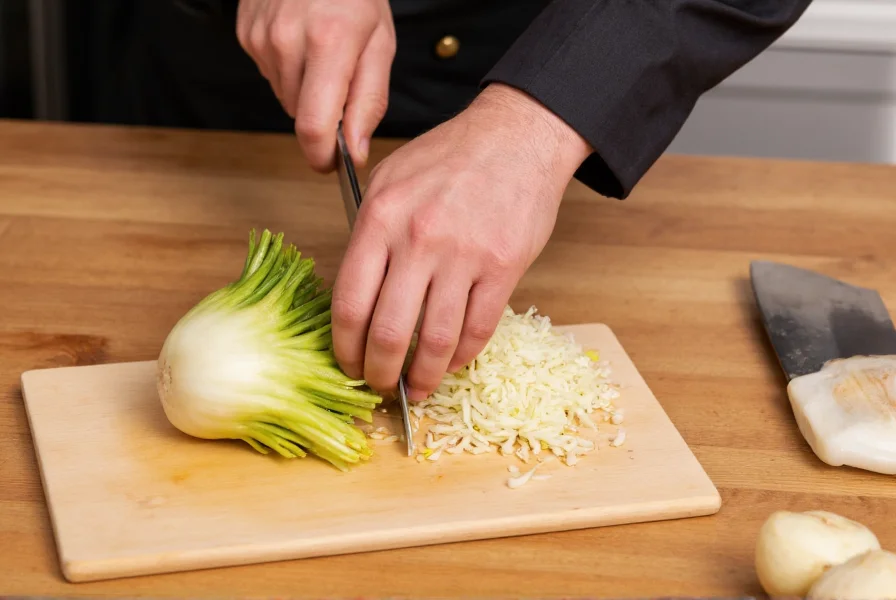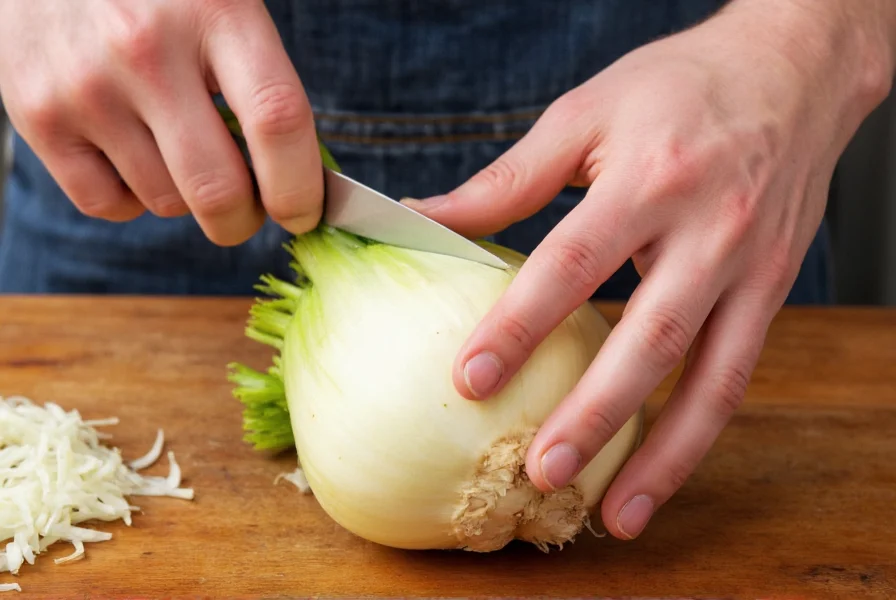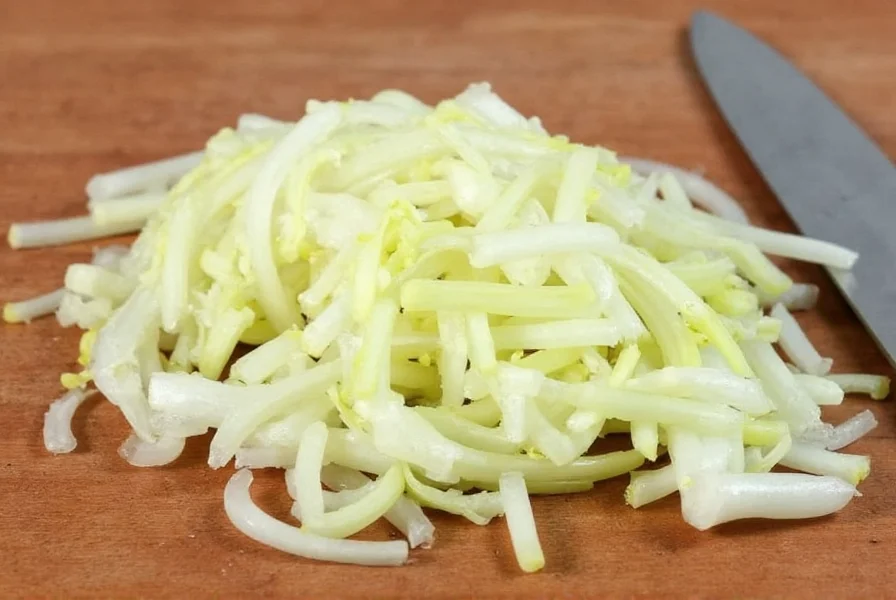Chopping fennel might seem intimidating if you've never worked with this aromatic vegetable before, but with the right technique, you'll transform its crisp bulb into perfectly uniform pieces every time. Whether you're preparing fennel for a refreshing salad, roasting fennel bulbs, or adding fresh fennel to soups, proper chopping ensures optimal texture and flavor distribution in your dishes.
Essential Tools for Chopping Fennel
You don't need specialized equipment to chop fennel effectively. Gather these basic kitchen tools:
- Sharp chef's knife (8-10 inches)
- Stable cutting board
- Vegetable peeler (optional)
- Colander for washing

Understanding Fennel's Structure
Fennel consists of three main parts, each requiring different handling:
| Part | Characteristics | Best Uses |
|---|---|---|
| Bulb | Crisp, white, layered structure with mild anise flavor | Salads, roasting, sautéing, grilling |
| Stalks | Tough, fibrous, similar to celery | Stocks, soups, stews (remove before serving) |
| Fronds | Feathery green tops with intense fennel flavor | Garnish, pesto, salad topping, herb blends |
Step-by-Step Guide: How to Chop Fennel
1. Preparation and Cleaning
Begin by rinsing the entire fennel bulb under cold running water. Use your fingers to remove any dirt between the layers. Shake off excess water or pat dry with a clean kitchen towel. This proper fennel preparation technique prevents slipping while chopping.
2. Trimming the Base and Fronds
Place the fennel bulb on your cutting board with the root end facing you. Using a sharp knife:
- Cut ¼ inch off the root end to create a stable flat surface
- Remove the feathery fronds by cutting 1-2 inches above the bulb
Set aside the fronds for garnish or recipe use. Store them in a damp paper towel inside a plastic bag in the refrigerator.

3. Removing Tough Outer Layers
Examine the outer layer of the bulb. If it appears dry, discolored, or tough, use a vegetable peeler or knife to remove it. Fresh fennel often has tender outer layers that don't require peeling—this efficient fennel preparation method saves time and reduces waste.
4. Slicing the Bulb
Place the trimmed bulb flat-side down on the cutting board:
- Cut vertically through the core to divide the bulb in half
- Lay each half flat side down on the board
- For slices: Cut crosswise into ¼-½ inch thick pieces
- For julienne: Make lengthwise cuts, then crosswise slices
- For fine dice: Make vertical cuts parallel to the core (without cutting through), then slice crosswise, then lengthwise
5. Handling Stalks and Fronds
The stalks near the bulb are tender enough to use. Slice them thinly along with the bulb. Tougher outer stalks work best in stocks. Chop the fronds finely with a rocking knife motion for garnish—this professional fennel chopping technique releases maximum flavor.
Storage Tips for Chopped Fennel
Store chopped fennel properly to maintain freshness:
- Place in an airtight container with a slightly damp paper towel
- Refrigerate for up to 4 days
- Do not wash before storing—moisture accelerates spoilage
- Store fronds separately from the bulb for best results
Common Fennel Chopping Mistakes to Avoid
Even experienced cooks make these errors when learning how to chop fennel correctly:
- Using a dull knife: Crushes the bulb instead of making clean cuts
- Not trimming enough from the base: Makes the halves unstable during chopping
- Discarding all stalks: Wastes edible, flavorful parts of the plant
- Cutting against the grain for salads: Creates bitter, stringy pieces
- Over-chopping the fronds: Releases too much intense flavor
Culinary Applications for Properly Chopped Fennel
Different chopping techniques serve specific culinary purposes:
- Thin slices: Perfect for raw fennel salads with citrus dressing
- Medium dice: Ideal for roasting with olive oil and herbs
- Small dice: Best for soups, stews, and sauces where fennel should blend in
- Julienne: Great for stir-fries and slaws
Frequently Asked Questions
Can you eat the entire fennel bulb when chopping?
Yes, the entire fennel bulb is edible when properly prepared. After trimming the tough base and any damaged outer layers, all remaining white and pale green portions can be chopped and used in recipes. The crisp texture and mild anise flavor work well in both raw and cooked applications.
What's the best knife technique for chopping fennel without crushing it?
Use a sharp 8-10 inch chef's knife with a smooth rocking motion rather than pressing down forcefully. Keep your fingers curled safely away from the blade while guiding the fennel. A sharp knife requires less pressure, preserving fennel's delicate cellular structure and preventing bruising that leads to faster spoilage.
How thin should I slice fennel for a salad?
For raw fennel salads, slice the bulb 1/8 to 1/4 inch thick using a mandoline or sharp knife. Thinner slices provide a more delicate texture that blends well with dressings and other salad ingredients. If using a knife, cut with the grain (parallel to the core) for the most tender results in raw applications.
Why does my chopped fennel turn brown quickly?
Fennel contains enzymes that cause browning when exposed to air, similar to apples. To prevent this, toss chopped fennel with a small amount of lemon juice or vinegar, or submerge it in cold acidulated water (1 tablespoon lemon juice per cup of water) until ready to use. Use within 24 hours for best quality.
Can I chop fennel in advance for meal prep?
Yes, you can chop fennel 2-3 days in advance for meal prep. Store it in an airtight container lined with a slightly damp paper towel in the refrigerator. Keep the bulb separate from the fronds, which should be stored in a separate container. Chopped fennel maintains its crisp texture best when not submerged in liquid until ready to use.











 浙公网安备
33010002000092号
浙公网安备
33010002000092号 浙B2-20120091-4
浙B2-20120091-4